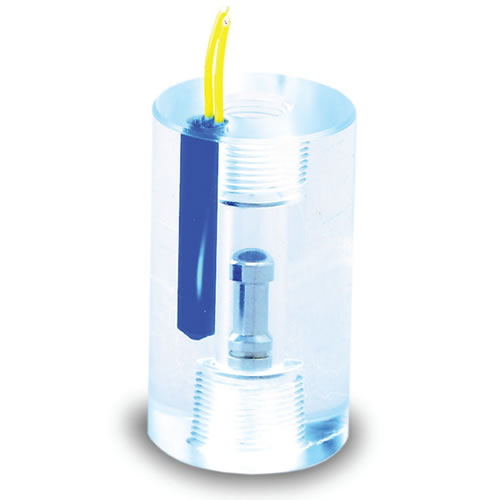Flow switches (or flow sensors) are often a crucial component for any manufacturing operation. With so many different options available on the market, how can you ensure you’re getting the right device for your application? Here you can learn more about the mechanics of our flow switches and how we can help make it easy for you to select the perfect solution for your needs.
Operation of a Flow Switch

Taking our popular LPH Series non-adjustable flow switch as an example, when air/water flows through the unit it causes the magnetic piston to move up at the calibration point. This displacement is caused by the pressure differential from the air/water flowing through the unit. The magnetic piston actuates a hermetically sealed reed switch, which is encapsulated in the body of the unit, out of the media wetted flow path. Decreasing the flow below the calibration point causes the reed switch to de-actuate. The LPH series is a fixed set point flow switch that has a predetermined calibration point, designed to act primarily as an air flow switch or water flow switch.
Choosing the Right Flow Switch
When it comes to selecting a suitable flow switch, there is no one “right” choice for every situation. The ideal flow switch will depend on the specific application, operating parameters and desired function required by the end user. Some of the most common factors considered are as follows:
- Accuracy – sometimes it’s critical for a flow switch to have a very tight accuracy tolerance around the desired switch point. Determining how important accuracy will be for your application will ultimately help to establish which flow switch model should be considered. We can offer flow switches with factory pre-set calibration (according to your exact flow rate, media and line pressure) to ensure a very highly accurate switch point.
- Cost – the price range for your ideal flow switch will again depend on the specifics of your application. In many cases, a standard cost-effective solution may fit the bill and tick all your boxes. In more challenging and demanding applications, you may require a customised flow switch designed as a bespoke solution. We can offer custom flow switches with many different options including special connections (such as VCR FaceSeal™ or Flanges), different construction and seal materials, bespoke wiring designs, specialty mounting holes or brackets and more.
- Durability – when assessing durability, you’ll want to consider not only the cost of replacing a flow switch, but also the cost of having your operations down until a flow switch can be replaced. By keeping this in mind whilst browsing the different options, this may help to shape the final decision. We can help guide you towards selecting the right solution and advise on different materials for any particularly aggressive or toxic media. Available in our standard range is Stainless Steel, Brass, Acrylic and Teflon® materials for flow switches.
Flow Switch Applications
- Gas Analysers - Gas or liquid flows to instruments (recorders, analysers, etc) are usually very low, but our selection of flow switches can instantly warn of flow stoppage or excess reduction due to plugging or malfunction of the device.
- Leak Detection - Our flow switches operate effectively as leak detectors. When installed downstream from valves, flow switches detect and signal if a tight shut-off has not made. If there is pipe rupture or a loose fitting downstream of the flow switch it will signal loss of fluid even though a downstream valve is tightly closed.
- Laser Cooling Systems - Flow switches can be installed in coolant lines and lubrication systems to ensure that vital areas are receiving adequate lubricant or coolant flow. Pressure gauges cannot ensure this. Flow of industrial gases (Hydrogen, Oxygen, Nitrogen, Argon, Carbon Dioxide, etc) can be detected and signalled by a flow switch.
- Compressed Air Systems - Most plant engineers are aware of air leakage in their plants. These leaks can arise from faulty valves in air tools, hose fittings, etc. In even moderate sized plants, air leakage (loss of power to air tools) can cost thousands of pounds per year. Air leakage puts more demand on compressors, greater capacity may be required resulting in higher capital requirements, higher overhead and higher product costs as a result. Flow switches installed in various circuits of the plant’s compressed air system can advise of air leakage through joints, fittings, hoses, or tools when air usage in a circuit is momentarily stopped.
- Heating, Ventilation, Air Conditioning and Refrigeration (HVAC/R) - Installed in a cooling tower circulating water line, the flow switch signals “No Flow” conditions or a reduction of flow below minimum requirements. This sounds an alarm or activates a compressor motor. When installed in a chilled water line, a flow switch can signal “Proper Flow Established” before compressors begin working. Before normal operations a flow switch can signal failure or overload of operating pumps and stop compressor motors.
- Boiler Systems - Installed on a discharge line, a flow switch can stop deep or shallow well pumps on loss of prime or other malfunction causing loss of flow. On turbine blue oil systems, a flow switch warns immediately of insufficient oil flow. Installed in front of or after filters, the flow switch advises time to clean and can activate by-pass valves as desired.
Other Flow Monitors and Flow Meters
Whether you require fixed set point (non-adjustable) flow switches or adjustable flow switches, continuous flow monitors or flow meters, we can help you with a suitable solution. To explore our full range of flow monitoring products, please visit our category page here.
For technical support on selecting the right component for your application, get in touch with our experienced engineers here.
